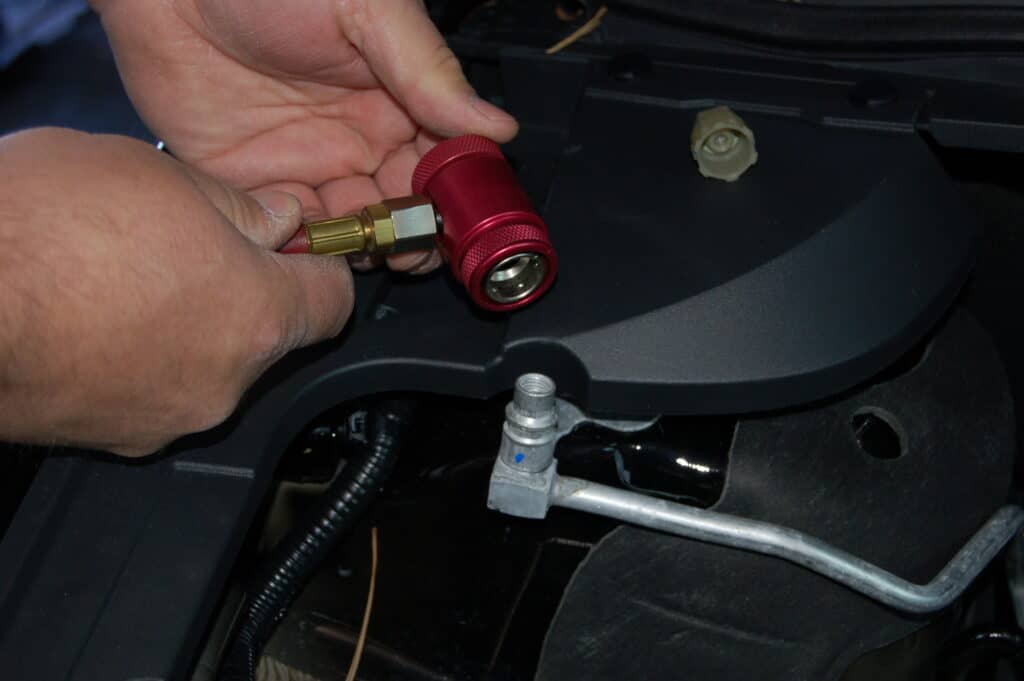Tank full of air!
By Steve Schaeber, MACS manager of service training
It amazes me just how many A/C problems can be fixed by simply using an R/R/R machine to perform a basic recycling procedure. The problem is usually caused by excessive air in a system, and since too few shops use a refrigerant identifier, they don’t know when these problems come up, nor how often they are solving problems by doing this.
Here’s how it works. An A/C system is supposed to be charged only with refrigerant and oil in the amounts specified by the vehicle manufacturer. Too much or too little of either, and we know the problems that result. We also know that an R/R/R machine is used to recover, recycle and evacuate a system before recharging it with the proper amount of refrigerant and (sometimes) oil. Additionally, we are aware that the two major contaminates they are designed to remove are moisture and air. It’s during these machine processes that things can go wrong.
Let’s say you’re working on a customer’s vehicle after they tried to fix it themselves. They don’t have a vacuum pump, and some air got mixed in during their repair. Your shop has a recovery machine, but not a refrigerant identifier, which can tell you how much air is in a system. No matter, we know that R/R/R machines are supposed to remove air during the process, so it’s good, right? Probably, but if your machine was built prior to 2008 (or does not meet the current SAE Standards), it’s likely to NOT have a feature called AAP (automatic air purge).
On machines without AAP, the operator has to manually purge air from the machine’s internal supply tank; without this purge, that air can get recharged back into the next system. The process involves comparing the pressure and temperature of the tank to the corresponding P/T chart (pressure / temperature chart) for the refrigerant you’re working with. If the pressure is equal to or lower than indicated on the chart, it is not necessary to vent air (or non-condensable gasses) from the tank. If the pressure is higher than indicated (based on the tank’s temperature), this means there is excessive air in the tank that needs to be bled off.
For example, if an R-134a tank’s temperature reads 80°F and its pressure reads 86 psi, things are OK. If the same 80°F tank reads 100 psi, there is too much air in the tank, and it must be removed. Since refrigerant is heavier than air, it will sink to the bottom inside the tank, so you can simply bleed the air off the top. Usually, the machine manufacturer will provide a hand valve to do this; if not, the tank’s low side valve usually works well.
Another way air gets mixed in is through leaking O-rings on A/C equipment. So, check your manifold gauge sets, A/C hoses, service couplers, and especially the hoses on your recovery machine. We’ve seen many examples of loose connections or cracked O-rings (particularly at the hose-to-machine connection) that leak and suck in air during the recovery process.
Why does excessive air matter? It takes up space in the system, raising pressures (and temperatures), and doesn’t transfer heat. A little extra air (below 2%) usually doesn’t cause a problem, but the more you add the higher the pressure gets. Since an increase in pressure is followed by an increase in temperature, you end up with warmer air coming out of the vents. Newer R/R/R machines that meet SAE Standards J2788, J2843 or J3030 automatically purge air from their internal tanks.
As for the identifier, it should be the FIRST tool you use on every A/C job, so you know what you’re dealing with. Not only for air concentration, but also mixed refrigerants and hydrocarbons, which can contaminate your shop’s supply tank.

Consult the manual for the machine you’re working on, and if you aren’t sure please contact MACS for assistance. We’re familiar with MOST of the R/R/R machines that are out there, and providing tech support for our MACS Members is just one of the many things we do for our members.
Thanks for reading!
If you like this content, there’s lots more when you join MACS as a member.
If you would like to contact the MACS staff call 215-631-7020 x 313, 309 , 311 M-F, 8:30am-5pm EDT.
You can read the whole issue of MACS ACTION magazine at this link:
https://read.nxtbook.com/macs/action_magazine/march_2021/index.html

Leave a Reply